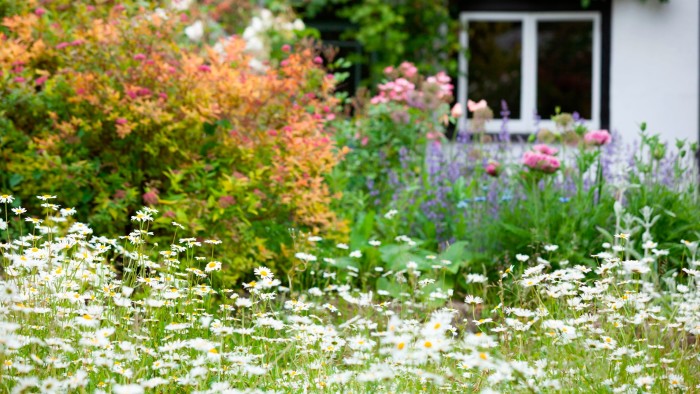Unlock the Editor’s Digest for free
Roula Khalaf, Editor of the FT, selects her favourite stories in this weekly newsletter.
This is the month when small “No Mow May” signs appear on my school run through the London borough of Lambeth, poking up through overgrown grass. I first saw them two years ago when Lambeth, along with 54 other UK local authorities, had bought into the idea that, for May, they would not cut the grass on council-managed green spaces.
No Mow May began in 2019 with a campaign by the conservation organisation Plantlife to persuade the UK’s estimated 20mn gardeners to let their springtime lawns grow wild. Apart from the catchy alliteration the month enables, the timing would allow early spring pollinators to find food in the first flush of daisies, buttercups, dandelions and other wild flowers. As the saying goes, weeds are just flowers in the wrong place.
The movement has spread beyond the garden gate, catching the imagination of public bodies in both the UK and the US. This was how I came to be standing with my sons outside a 1970s tower block looking excitedly at a carpet of red clover. “What happens when it isn’t May any more?” one asked. A few weeks later, we found out: the council cut it.
This, critics say, is the flaw behind the movement. While there is plenty of evidence to support the claim that biodiversity increases by letting grasses grow, there’s little to say this is sustained. Furthermore, a widely cited 2020 study used to support No Mow May in the US was found to be filled with errors, prompting the New York Times to withdraw its supportive story. Other claims that not mowing cuts both carbon and council tax may also be flawed. Warwick District Council reported a £29,000 overspend last year thanks to hiring flails to cut the longer grass after a month of growth.
I want No Mow May to work: I really do. A 2021 report by Buglife and a wildlife trust found the UK’s flying insect population has shrunk by up to 60 per cent in the past two decades, while “urbanisation” is named as one the key stated contributors to biodiversity decline in the 2019 State of Nature Report.
According to campaign group Nature 2030, there are 85,000 hectares of accessible public green spaces under council control. Its 2024 report argues that “road verges and green spaces . . . collectively could provide a network of nature corridors across the UK” and “have an important part to play in nature’s recovery”. According to the Wildlife Trust, £690mn worth of UK crops rely on pollinators annually. How councils manage green spaces affects more than whether bees are fed — it affects whether we are too.
Astonishingly, grass verges now cover 1.2 per cent of UK land. In 2021, Inkcap, an ecological newsletter, published a report on verge cutting. It revealed that where some councils, like Sheffield’s, had reduced mowing schedules due to budget costs, there was an unintended consequence. Longer grass clippings must be dealt with differently: removed or piled up to the side rather than left to mulch down, where they refertilise the soil. But wild flowers thrive in poorer soils. As a result, road verges now host nearly half of all the UK’s wild flower species — over 700, including rarities such as harebell, tower mustard, spiked rampion and 29 types of orchid. And each flower-rich mile of verge produces enough nectar to feed millions of pollinators.
Inkcap’s report made another point. Frequent mowing costs biodiversity and money. One of London’s poorest boroughs, Tower Hamlets, was spending £10,000 a year on mowing 0.12 miles of grass verge every 14 days for six months: £52 a square metre. Never mind the butterflies: that kind of cost is hard to justify.
Even if long-term evidence is limited, No Mow May shows no sign of slowing. According to Plantlife’s Mark Schofield, 56 UK councils registered to take part in 2024. Perhaps, like most ecological experiments, time is needed to see the benefits. Dorset council claims to have reduced its mowing bill by nearly half over seven years of taking part, paying back their machinery investment.
Schofield is keen to clarify the motive behind the movement is “to depart from tradition and manage areas so they flower and provide shelter for wildlife throughout the summer”. He points to the unused potential of public spaces, in particular the thousands of publicly owned football pitches in England: “Often the whole area is mown. A 10-metre unmown margin around each one would create the equivalent of 100 football pitches of wildlife per county.”
As my sons and I breathed in the smell of freshly mown grass and mourned the dandelions, I decided the point may not be whether weeds in May save bees, carbon or money; it is about shifting our sense of what looks “good” — of seeing a shorn green lawn not as a sign of order but, as the American writer Michael Pollan put it in his 1989 essay “Why Mow?”, as “nature purged of sex and death”.
Instead of seeing neglect — Harrow council’s reason not to participate — No Mow May might help us see life. Now some boroughs are pushing mowing even later: Ealing has committed to “Let It Bloom June”. Perhaps this can be followed by “Let It Fly July”. Then maybe one day my sons and I will make our way home from school in late summer and see a swallow skimming tower block grasslands as they do when haymaking. What a thought.
Find out about our latest stories first — follow @ft_houseandhome on Instagram
